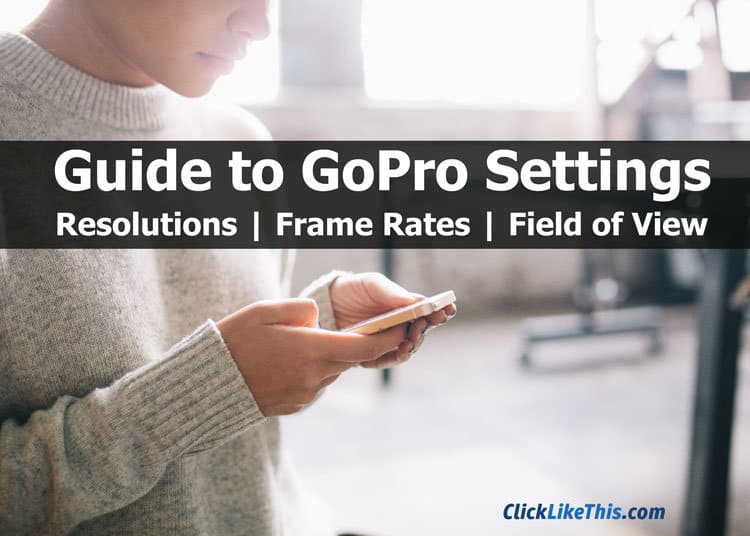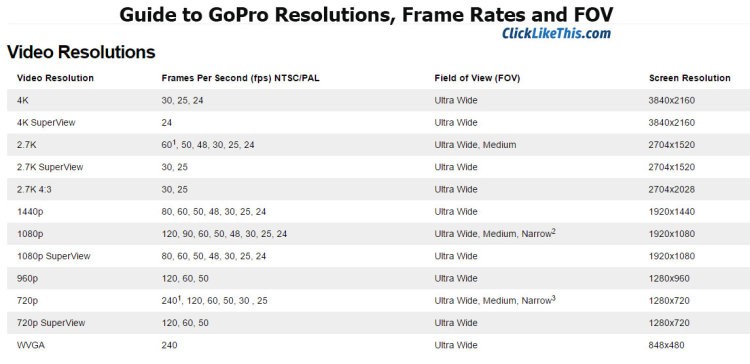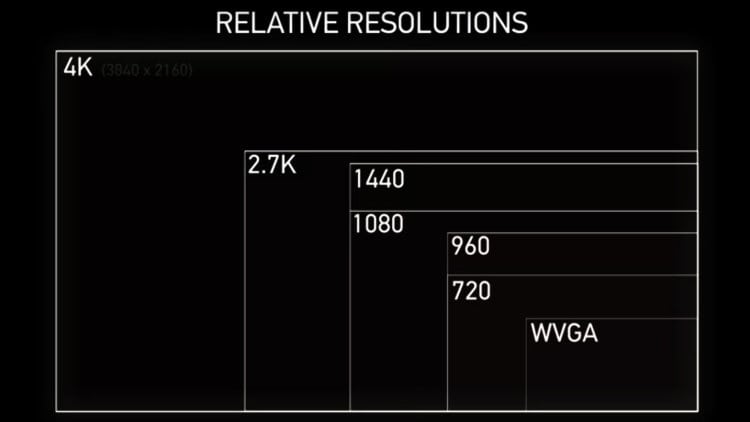In this post, you’ll learn about the basic GoPro settings: resolutions, frame rates, and field of view (FOV). Both what they are – and the best time to use each one.

Watch this video post: 12 GoPro Hero4 video settings
Before we get into all the details, here is a quick reference guide for GoPro settings: resolutions, frame rates, and field of view:
Quick Reference: 4 GoPro Settings for Video
While it’s great to have countless settings, it can be kind of overwhelming (and unnecessary). Here are the 4 GoPro video settings you should use:
- Regular Video: 1080p at 60 fps. This is your everyday video setting. The 1080p means you’re shooting in HD video. Because you’re capturing at 60 frames per second, you can create a slow-motion video if you want. Quality and versatility.
- Super Slow Motion: WVGA at 240 fps. This is a low-resolution video setting – but because it captures at 240 frames per second, it is perfect for super slow-motion video. Possible subjects include fireworks, splashing water, spectacular jumps, and exploding objects.
- POV (Point of View): 1080 SuperView. This HD video setting is perfect for any point-of-view filming. This includes helmet and chest cams – because it captures more height than the standard GoPro video settings. Shoot at up to 80 frames per second.
- Slow Motion POV: 720 SuperView. This has the same aspect ratio (4:3) as 1080 SuperView – but with a lower resolution. The benefit of this setting is that you can shoot at 120 frames per second – great for slow-motion action shots.
A note about GoPro SuperView: SuperView (both 720 and 1080) shoots at the 4:3 aspect ratio (capturing more height) and squishes it into the 16:9 video format.
Have a GoPro Hero4 Silver? Here are the basic settings for the Hero4 Silver.
Guide to GoPro Settings: Resolutions, Frame Rates, and FOV
Now for all the details about GoPro resolutions, frame rates, and FOV.
It’s true that the GoPro is pretty simple to use. It has just three buttons – each with two features:
- Settings/tag button: located on the side
- Power/mode button: located on the front
- Shutter/select button: located on top
But to get the best footage, you’ll need to understand three things: resolution, frame rate, and field of view (FOV).
Here is an overview of what the Hero4 Black can shoot.
Let’s consider each feature in detail.
What is Resolution?
In the context of GoPro photography, resolution refers to the pixel dimensions of the video that the camera will capture.
Higher resolution means better quality video. On the other hand, the higher the resolution, the larger the file size and the faster the memory card will fill up.
What is Frame Rate?
Frame rate refers to the number of frames (or images) per second. Standard video is shot at 30 frames per second (fps). Frame rates above 30 are required for producing smooth slow-motion video.
GoPro cameras shoot between 24 and 240 fps. Even at just 60 fps, you can slow the video to half speed, and maintain crisp HD video.
What is Field of View?
Field of view (FOV) refers to the amount of the scene that the camera can capture.
To put it in perspective, if the camera could capture everything in front of the lens, it would have a 180-degree FOV. With the standard GoPro ultrawide FOV, you capture almost everything physically in front of the lens.
- Ultrawide: 170-degree FOV
- Medium: 127-degree FOV
- Narrow: 90-degree FOV
Below the video, I’ll explain the settings in more detail.
GoPro Settings: Resolutions, Frame Rates, and Field of View
Learn about shooting in Protune for the best GoPro color.
GoPro Resolutions, Frame Rates, and Field of View
GoPro Resolution Settings
This chart shows the relative size and aspect ratio of each setting.
Here are the available video resolutions in a GoPro camera. While these nine settings will probably feel overwhelming, fear not.
At the beginning of the post, I included a breakdown of the 4 GoPro settings you should be using.
Video resolution: screen resolution (width x height)
- 4K Video: 3840 x 2160 This is the highest GoPro resolution. You can shoot at either 24, 25, or 30fps. Normal video is 30fps. Despite its lower frame rate, this setting is great for wide panoramas or sunset time-lapse videos – really anything that is not moving. If you can shoot it on a tripod (or another fixed mount) then 4K might be the right setting. Avoid the 4K setting for any action shots. The frame rate just won’t be able to keep up.
- 2.7K: 2704 x 1520 This is an excellent setting because you can shoot at this super high resolution and capture at a frame rate from 24 up to 60. This is great for mounted shots. If you plan on slowing the action down, I recommend 1080p at either 60 or 80fps.
- 1440p: 1920 x 1440. Use this video resolution for all point-of-view (POV) shots. This is essentially the same as 1080p – except that it is taller. It is shot at an almost square 4:3 aspect ratio – capturing more of your point of view: skis, handlebars, horizon, or trail. Use this for chest cam, head cam or any setting where you want to see more above or below. In post-production, just stretch horizontally to fill the standard frame.
- 1080p: 1920 x 1080 This is the most versatile filming resolution. You can shoot from 24 to 60fps – allowing for fluid slow motion. This is great for b-roll, car-mounted shots, and follow cams. If you aren’t sure of the best resolution, choose this one – at 60fps. It is HD and allows you to slow down the action.
- 1080 SuperView: 1920 x 1080 This is essentially the same as 1440p – but stretched to fill a standard 1080p frame. You’ll get the same extra above/below footage but without having to adjust in post-production. This setting is best for POV body-mounted shots (chest or head mounts) because it gives more of what you see in front of you.
- 960p: 1280 x 960 This is similar aspect ratio to 1440p, but a lower resolution. It is the same as 720p (see below) but has more height in the frame. The reason to choose 960p instead of 1440p is that it can film at up to 120fps – allowing you to slow the action to a quarter of its original speed. This is great for the perfect POV slow-motion video.
- 720p: 1280 x 720 This is great for ultra-high slow motion. If you don’t need the above/below frame (like 960p offers) then this is a great choice. Consider this setting for Instagram videos whenever you don’t need that high resolution.
- 720 SuperView: 1280 x 720 This is similar to 1080 SuperView but with a lower resolution. Shoots at the 4:3 aspect ratio with the extra view above and below and squishes it into the 720 frames. Great for POV videos.
- WVGA: 848 x 480 This is the lowest resolution mode – and allows shooting at 240 fps. This has limitations on large screens but is great for a web video or Instagram. Use this to experiment with super slow-motion effects.
Resolution vs Frame Rates
To get a higher frame rate, you need to reduce your resolution. The lower resolution essentially means a lower-quality video.
Before you decide on the resolution or frame rate, you need to decide on the video you want to produce. What is the end goal of the video?
How to Choose Your GoPro Field of View
There are no rules when choosing FOV. You’ll want to experiment with these different settings and see how they affect your footage.
- Wide: To get an immersive view and smoother footage, choose wide FOV.
- Medium and Narrow: Best if you are sure that you can shoot a steady shot. Maybe on a stationary mount or tripod. These two FOVs can give a different feel than the standard wide-angle GoPro shot.
Your Turn
What’s your question or comment about GoPro resolutions, frame rates, and field of view? Please join me in the comments below.
More reading: Learn how to eliminate GoPro lens fog
- About the Author
- Latest Posts
Hey, I’m Bryan! I’m a content creator and co-founder of Storyteller Tech.
Experienced GoPro Videographer: I’ve been shooting with GoPro cameras for over 11 years. My first GoPro was the Hero3 Silver, bought for a Galapagos work trip in 2012. Today I own 20+ action cameras, including GoPro, DJI, and Insta360 cameras.
Professional Creator: Dena and I have developed video and content marketing plans for numerous international travel brands. And we also run several content businesses.
Bryan also creates at Storyteller.Travel and is co-founder of Storyteller Media, a Canadian-based publishing company.




Johnny
Friday 26th of August 2022
Medium is GONE on the GoPro Hero 10. It appears it was replaced by Linear.
Thomas Davenport
Sunday 17th of March 2019
Like a comment above in 2016, I too found the settings were not available as you described. I’m trying to get 30 frames option at 4K on my Hero 4 black but to only options i see are 24 or 25. No 30. Why is this?
Tomi Kuisma
Monday 23rd of December 2019
@Thomas Davenport I have a same problem. Did you manage to find out how to increase fps to 30 at 4k?
daveclark966
Thursday 18th of October 2018
Avdshare Video Converter can change almost all kinds of video format frame rate, including AVI, VOB, MP4, MXF, FLV, AVCHD, MOV, SWF, MKV, etc.
John McNeill
Thursday 3rd of May 2018
I'm trying to mount a camera above a foosball table, ultimately to display the playfield on a large flat screen to study shots in slow motion. I know little. Can you point me in the right direction?
David
Monday 19th of February 2018
Hi Bryan I’m using a Hero 4 Siver to film water skiing (ie. from boat ski pole to skier distance ~50’). I’m finding that skier looks very small on Med or Linear FOV so am using narrow FOV. Hovever, read that narrow FOV “crops into the sensor and reduces resolution and image quality! Am wondering if this is true or just speculation, my impression is that linear/Med FOV better image than narrow???am I now biased? All shooting at 59fps(PAL) res 1080p. Your comments would be greatly appreciated. Kind Regards David